The Path and Practice of Vajra Romance
By Khandro Déchen
Buddhistdoor Global
| 2018-12-23 | 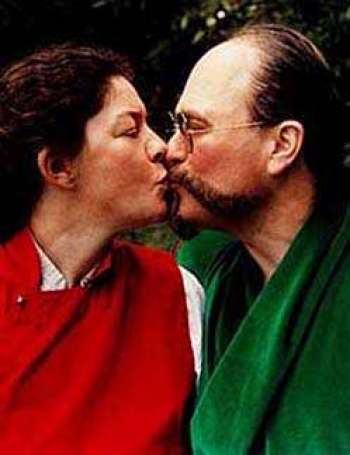 Khandro Déchen & Ngak’chang Rinpoche. Image courtesy of the author
Khandro Déchen & Ngak’chang Rinpoche. Image courtesy of the authorI was born in England in 1960. I remember feeling religious as a child, although my parents didn’t encourage it in me or my sister. They’d both had their fill of church-going in childhood and didn’t see a need for it in our lives.
My personal spiritual quest initially took me to the church where I was christened, but somehow that didn’t provide the answers I was seeking. I therefore channeled my religious feelings into a career in nursing. This brought me to Cardiff, where I had a chance meeting with Ngak’chang Rinpoche, a Vajrayana Buddhist teacher. He had not long returned to Britain after spending 12 years in retreat and study in the Himalayas. In his explanations, I encountered a religion which enabled me to comprehend the entirety of my life experience. It offered the existential direction on this seemingly endless journey that I had previously lacked.
Ngak’chang Rinpoche was a ngakpa, a non-celibate ordainee from the Nyingma tradition—the oldest school of Tibetan Buddhism. When we met in 1982 the ngakpa tradition was unheard of in Britain, but one of Ngak’chang Rinpoche’s main teachers, Düd’jom Rinpoche (d. 1987), the head of the Nyingma school, had asked him to establish the tradition in the West.
I was his student for a decade before we fell in love, married, and later became a teaching couple. It was my declaration of love that began our romantic relationship as his position as my Lama would not allow him to initiate it. He would have considered it an abuse of authority because the Vajrayana student-teacher relationship is inherently unequal in terms of power and influence.
The power differential is well known in dangerous sports such as rock climbing, scuba diving, horse riding, or skydiving: learning how to engage in activities where there is physical risk requires suspending the primacy of individual perception and judgement. This is necessary in order to acquire expertise. It would be ridiculous to debate or disagree with the teacher on a vertical cliff face, but it goes without saying that it is wise to check the knowledge and credentials of an instructor before training.
It is similar in taking a vajra master as one’s lama. It has to be a conscious and formal decision between student and lama. This point is only reached on the culmination of years of study and practice, during which time students come to entertain the possibility of extending the spiritual journey beyond their rationale. During a prolonged period of working with a lama, students gain a degree of self-transparency which causes them frustration with their own systems of subjective, self-referencing logic, and it is only at this point that students consider entering a vajra relationship.
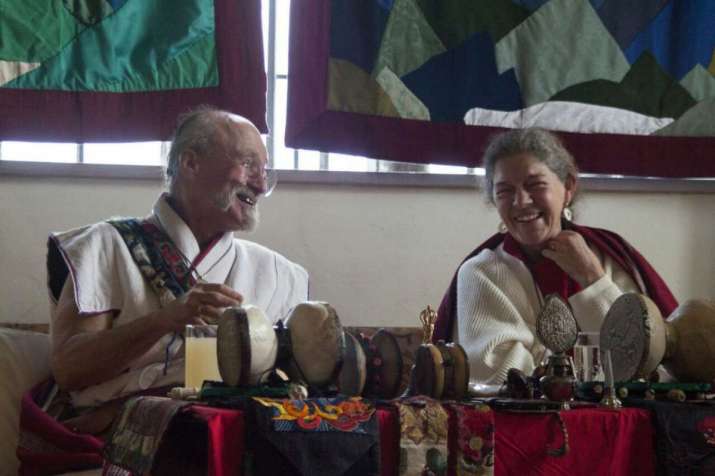 Khandro Déchen & Ngak’chang Rinpoche, a humorous moment during teachings. Image courtesy of the author
Khandro Déchen & Ngak’chang Rinpoche, a humorous moment during teachings. Image courtesy of the authorThis was the context in which I fell in love with Ngak’chang Rinpoche. The situation could have been claustrophobic, had he been heavy handed. Had he stepped back completely in his role as my lama, he would have ceased to be who he was. Either way would have resulted in the loss of our teacher-student relationship. In Ngak’chang Rinpoche’s view, however, the moment we became a romantic couple was the point at which we became equal in being each other’s lama. This is one of the tenets of vajra romance—one of the core Vajrayana teachings.
Vajra romance has been practiced by couples in the non-celibate traditions throughout Vajrayana Buddhism. It is a practice for partners by which they may reach realization. A vajra partnership is therefore more potent and more efficacious than practicing as an individual. The method is simply one of maintaining the courtship behavior of kindness, openness, trust, and respect. These aspects of courtship behavior express the two fundamental qualities of Buddhist practice—wisdom and compassion. Although the method sounds simple, however, the theoretical discipline of vajra romance requires book-length explanation.
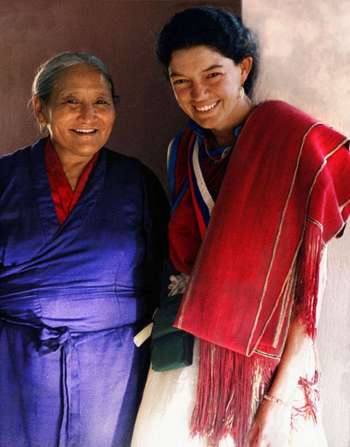 Khandro Déchen with one of her main teachers, Jomo Sam’phel Déchen Rinpoche. Image courtesy of the author
Khandro Déchen with one of her main teachers, Jomo Sam’phel Déchen Rinpoche. Image courtesy of the authorThis kind of relationship provides the best environment for nurturing children into self-reliant, adaptable individuals who will become the next generation of parents. We model relationships for our children, so the quality of such affiliations is vital for the future of humanity.
Predictably, at the beginning of our romance I did not feel myself to be an equivalent lama. Our relationship challenged my limited, fixed notion of capacity. Ngak’chang Rinpoche reminded me of my infinite capability of non-dual realization, and I recognized that I didn’t need to feel like anything other than myself because having to experience according to prescribed criteria is merely further self-referential clinging to the security of definition. I understood that it would be unthinkable to project a persona as part of being a teacher. It was inconceivable to be anything other than myself. This was made simple by the fact that Ngak’chang Rinpoche is always natural and never anything other than himself when he teaches. Approaching the teacher role from a practice perspective means forgetting inadequacy and living to the best of my ability and integrity.
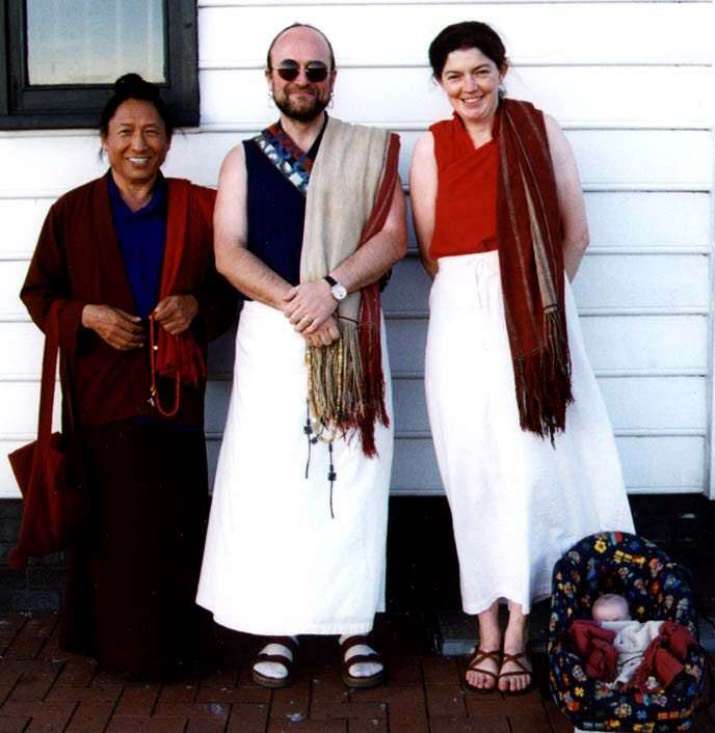 Khandro Déchen with our friend, Lama Tharchin Rinpoche (d. 2013), and Ngak’chang Rinpoche and 4 week old son, Robert. Image courtesy of the author
Khandro Déchen with our friend, Lama Tharchin Rinpoche (d. 2013), and Ngak’chang Rinpoche and 4 week old son, Robert. Image courtesy of the authorThis was made curiously easier by virtue of the fact that Ngak’chang Rinpoche immediately became open to alternative suggestions. He would often defer to my proposals when we were developing systems of teaching, and he quickly noticed that I enjoyed structure.
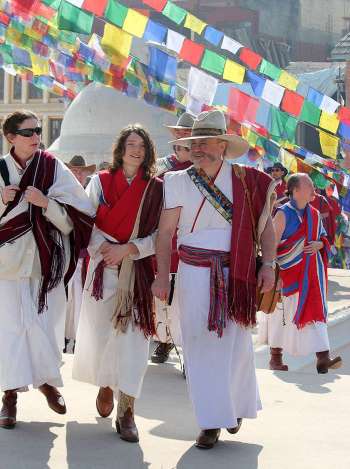 Khandro Déchen on pilgrimage in Bodhanath, Nepal, with Ngak’chang Rinpoche and son Robert (Düd’dül Dorje) aged 15. Image courtesy of the author
Khandro Déchen on pilgrimage in Bodhanath, Nepal, with Ngak’chang Rinpoche and son Robert (Düd’dül Dorje) aged 15. Image courtesy of the authorWe had been together for only a year or so before we had our first child. Creating a family is a life-filling event that leaves little time for study and practice. However it provides vast opportunities for practice in everyday life: training in living the view. The early years of a child’s life require the practice of emptiness on the part of parents—of rarely getting what they want. The best plans tend to disintegrate according to the needs of toddlers. Being a parent requires dancing with circumstances; moving from structure to chaos without warning, which is akin to the nature of meditation. Life with children functions as a practice of wisdom and compassion—although it is rarely recognized as such outside of the non-celibate lineages.
In his actions as a lama, Ngak’chang Rinpoche oozes Vajrayana like a saturated sponge. He has never prescribed how I should be, as a teacher, but rather has helped me to understand principles, such as ascertaining the assumptions behind people’s questions. His example has helped me to discover my own humor and aptitude with analogies based on my own experiences.
I teach as part of a couple whose approach is diverse. I have a plan in terms of what I intend to convey, although as a result of audience questions, the plan tends to move in different directions. Ngak’chang Rinpoche never has a plan, he simply responds and interleaves with me as I develop any subject of teaching. Understanding Vajrayana derives from relating personally with teaching and practice and applying it in terms of living the view. The first step in this process inevitably involves question and discussion—if there is no questioning and subsequent application to life of what is learnt, then one may be left with little more than a pleasant memory rather than the real understanding and functional knowledge that facilitate profound change.
See more
Drala Jong
Buddhistdoor Global Special Issue 2018
Women of Buddhism




















